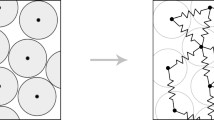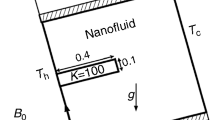Abstract
A hierarchical approach for modelling the thermal response of large-scale granular assemblies by coupling the micro-scale particle-level thermal interactions with the macro-scale continuum system is proposed. The coupling is done by using a machine learning tool that is trained to replicate the effect of discrete particle nature on the macro-scale system using finite elements. A trained Artificial Neural Network (ANN) tool that can estimate the effective local thermal conductivity for each finite element considering the influence of the presence of stagnant gas in the interstitial voids, gas pressure and the granular microstructure is used. This way of hierarchical coupling using ANN eliminates the need to perform thermal discrete element simulations for each finite element at every increment by directly predicting the effective local conductivity. The proposed hierarchical approach is applied to a breeder blanket of fusion reactor that consists of more than 15 million particles to demonstrate the efficacy of the method. The influence of the drop in gas pressure across the breeder unit and the heat generation on the temperature distribution of the full-scale breeder unit is analysed numerically.














Similar content being viewed by others
Notes
Note that the methodology can be applied even for an assembly with variable local packing fraction.
References
Cismondi F, Boccaccini LV, Aiello G, Aubert J, Bachmann C, Barrett T, Barucca L, Bubelis E, Ciattaglia S, Del Nevo A et al (2018) Progress in EU breeding blanket design and integration. Fusion Eng Des 136:782–792
Ying A, Reimann J, Boccaccini L, Enoeda M, Kamlah M, Knitter R, Gan Y, van der Laan JG, Magielsen L, Di Maio PA et al (2012) Status of ceramic breeder pebble bed thermo-mechanics R&D and impact on breeder material mechanical strength. Fusion Eng Des 87(7–8):1130–1137
Zhang D, Zhou J, Wu K, Li Z (2005) Granular phase changing composites for thermal energy storage. Sol Energy 78(3):471–480
Rady M (2009) Granular phase change materials for thermal energy storage: experiments and numerical simulations. Appl Thermal Eng 29(14–15):3149–3159
Abel J, Kornyshev AA, Lehnert W (1997) Correlated resistor network study of porous solid oxide fuel cell anodes. J Electrochem Soc 144(12):4253–4259
Singhal SC (2000) Advances in solid oxide fuel cell technology. Solid State Ion 135(1):305–313
Cundall PA, Strack ODL (1979) A discrete numerical model for granular assemblies. Géotechnique 29(1):47–65
Herrmann HJ, Luding S (1998) Modeling granular media with the computer. Contin Mech Thermodyn 10(4):189–231
Kruggel-Emden H, Simsek E, Rickelt S, Wirtz S, Scherer V (2007) Review and extension of normal force models for the discrete element method. Powder Technol 171(3):157–173
Gan Y, Kamlah M (2010) Discrete element modelling of pebble beds: with application to uniaxial compression tests of ceramic breeder pebble beds. J Mech Phys Solids 58(2):129–144
Radjaï F, Dubois F (2011) Discrete-element modeling of granular materials. Wiley, Hoboken
Annabattula RK, Gan Y, Kamlah M (2012) Mechanics of binary and polydisperse spherical pebble assembly. Fusion Eng Des 87(5):853–858
Desu RK, Gan Y, Kamlah M, Annabattula RK (2016) Mechanics of binary crushable granular assembly through discrete element method. Nuclear Mater Energy 9:237–241
Siu WWM, Lee SH-K (2004) Transient temperature computation of spheres in three-dimensional random packings. Int J Heat Mass Transf 47(5):887–898
Kanuparthi S, Subbarayan G, Siegmund T, Sammakia B (2008) An efficient network model for determining the effective thermal conductivity of particulate thermal interface materials. IEEE Trans Compon Packag Technol 31(3):611–621
Yun TS, Evans TM (2010) Three-dimensional random network model for thermal conductivity in particulate materials. Comput Geotech 37:991–998
Moscardini M, Gan Y, Pupeschi S, Kamlah M (2018) Discrete element method for effective thermal conductivity of packed pebbles accounting for the Smoluchowski effect. Fusion Eng Des 127:192–201
Peeketi AR, Moscardini M, Vijayan A, Gan Y, Kamlah M, Annabattula RK (2018) Effective thermal conductivity of a compacted pebble bed in a stagnant gaseous environment: an analytical approach together with dem. Fusion Eng Des 130:80–88
Gan Y, Kamlah M (2007) Identification of material parameters of a thermo-mechanical model for pebble beds in fusion blankets. Fusion Eng Des 82(2):189–206
Duran J (2012) Sands, powders, and grains: an introduction to the physics of granular materials. Springer, Berlin
Radjai F, Roux JN, Daouadji A (2017) Modeling granular materials: century-long research across scales. J Eng Mech 143(4):04017002
Guo N, Zhao J (2014) A coupled fem/dem approach for hierarchical multiscale modelling of granular media. Int J Numer Methods Eng 99(11):789–818
Liu Y, Sun W, Yuan Z, Fish J (2016) A nonlocal multiscale discrete-continuum model for predicting mechanical behavior of granular materials. Int J Numer Methods Eng 106(2):129–160
Zehner P, Schlünder EU (1970) Wärmeleitfähigkeit von schüttungen bei mäßigen temperaturen. Chem Ing Tech 42(14):933–941
Zhou Zhao, Feng KM, Feng YJ (2010) Theoretical calculation and analysis modeling for the effective thermal conductivity of \(\text{ Li }_4\text{ SiO }_4\) pebble bed. Fusion Eng Des 85(10):1975–1980
Weidenfeld G, Weiss Y, Kalman H (2004) A theoretical model for effective thermal conductivity (ETC) of particulate beds under compression. Granul Matter 6(2–3):121–129
Gusarov AV, Kovalev EP (2009) Model of thermal conductivity in powder beds. Phys Rev B 80(2):024202
Desu RK, Peeketi AR, Annabattula RK (2019) Artificial neural network-based prediction of effective thermal conductivity of a granular bed in a gaseous environment. Comput Particle Mech 6(3):503–514
Pupeschi S, Knitter R, Kamlah M (2017) Effective thermal conductivity of advanced ceramic breeder pebble beds. Fusion Eng Des 116:73–80
Batchelor GK, O’Brien RW (1977) Thermal or electrical conduction through a granular material. In: Proceedings of the royal society of London. Series A, mathematical and physical sciences, pp 313–333
MATLAB (2010) version 7.10.0 (R2010a). The MathWorks Inc., Natick, Massachusetts
Reddy JN (2005) An introduction to the finite element method, 3rd edn. McGraw Hill Education (India) Private Limited, New Delhi
van der Laan JG, Reimann J, Fedorov AV (2016) Ceramic breeder materials. In: Reference module in materials science and materials engineering, Elsevier. https://doi.org/10.1016/B978-0-12-803581-8.00733-5
Cismondi F, Kecskés S, Ilic M, Légrádi G, Kiss B, Bitz O, Dolensky B, Neuberger H, Boccaccini LV, Ihli T (2009) Design update, thermal and fluid dynamic analyses of the EU-HCPB TBM in vertical arrangement. Fusion Eng Des 84(2–6):607–612
Abou-Sena A, Arbeiter F, Boccaccini LV, Schlindwein G (2014) Measurements of the purge helium pressure drop across pebble beds packed with lithium orthosilicate and glass pebbles. Fusion Eng Des 89(7–8):1459–1463
Pereslavtsev P, Lu L, Fischer U, Bitz O (2014) Neutronic analyses of the HCPB demo reactor using a consistent integral approach. Fusion Eng Des 89(9–10):1979–1983
Ergun S (1952) Fluid flow through packed columns. Chem Eng Prog 48:89–94
Löbbecke B, Knitter R, Rohde M, Reimann J (2009) Thermal conductivity of sintered lithium orthosilicate compacts. J Nuclear Mater 386:1068–1070
Liu YY, Tam SW (1985) Thermal conductivities for sintered and sphere-pac \(\text{ Li }_2\text{ O }\) and \(\gamma \)-\(\text{ LiAlO }_2\) solid breeders with and without irradiation effects. Fusion Sci Technol 7(3):399–410
Petersen H (1970) The properties of: density, specific heats, viscosity, and thermal conductivity at pressures from 1 to 100 bar and from room temperature to about 1800 k. In: Technical report. Risø National Laboratory, Roskilde. Forskningscenter Risoe. Risoe-R, No. 224
Lide DR (2012) CRC handbook of chemistry and physics. CRC Press, Boca Raton, p 12J204
Author information
Authors and Affiliations
Corresponding author
Ethics declarations
Conflict of interest
The authors declare that they have no conflict of interest.
Additional information
Publisher's Note
Springer Nature remains neutral with regard to jurisdictional claims in published maps and institutional affiliations.
Rights and permissions
About this article
Cite this article
Peeketi, A.R., Desu, R.K., Kumbhar, P. et al. Thermal analysis of large granular assemblies using a hierarchical approach coupling the macro-scale finite element method and micro-scale discrete element method through artificial neural networks. Comp. Part. Mech. 6, 811–822 (2019). https://doi.org/10.1007/s40571-019-00265-w
Received:
Revised:
Accepted:
Published:
Issue Date:
DOI: https://doi.org/10.1007/s40571-019-00265-w




